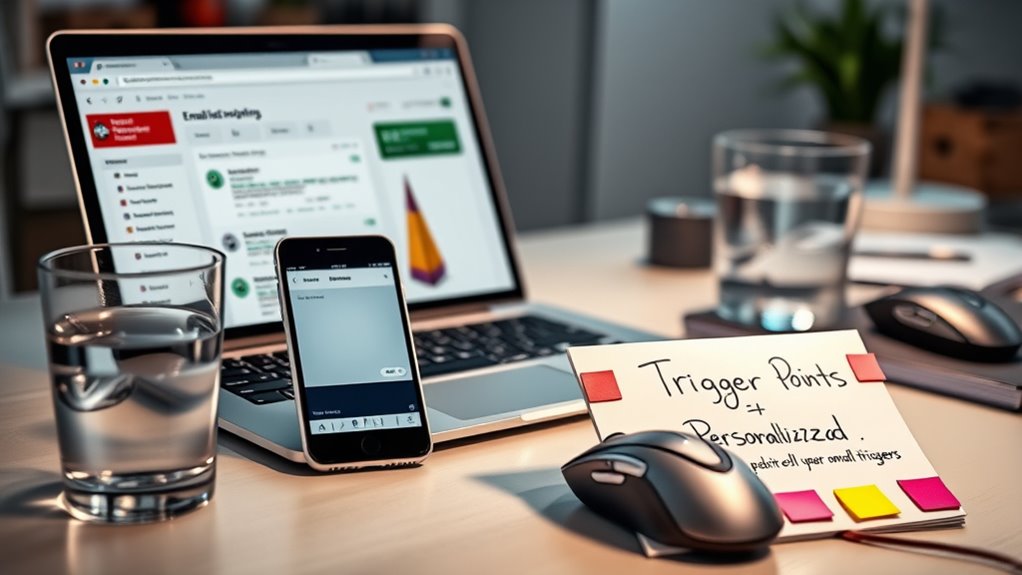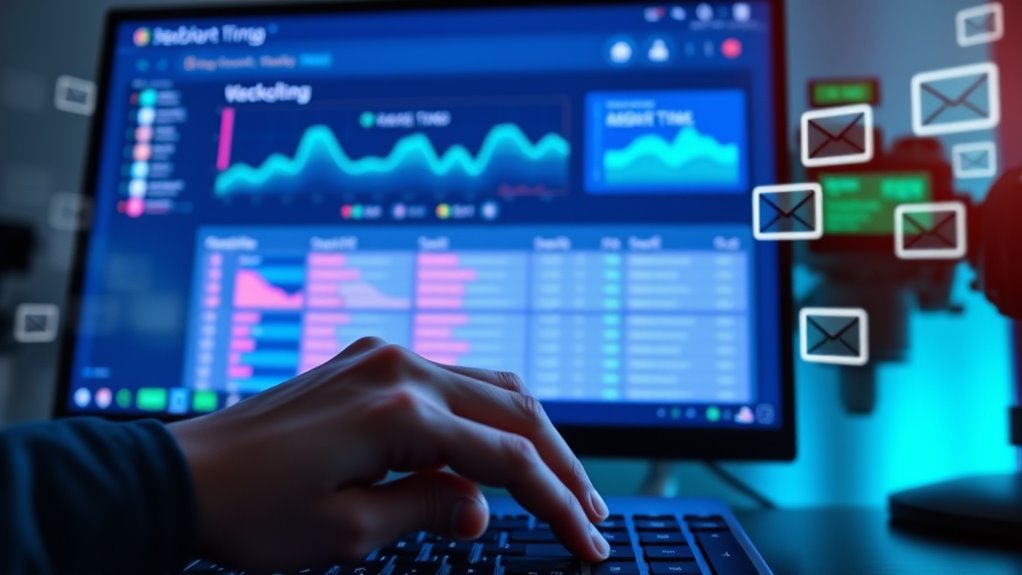Using webhooks to trigger hyper-personalized emails allows you to automatically send targeted messages based on real-time user actions. By setting up secure endpoints and defining specific triggers, you can instantly respond to behaviors like purchases or website visits. This guarantees your emails are timely and relevant, boosting engagement. To make the most of this, you’ll want to learn how to optimize configuration and maintain security—all vital details that can considerably improve your campaign results.
Key Takeaways
- Integrate webhooks with customer actions like purchases or website visits to trigger personalized email workflows instantly.
- Validate and transform webhook payload data to extract relevant user attributes for tailored messaging.
- Use real-time webhook data to dynamically adjust email content based on recipient behavior and preferences.
- Implement security measures such as encryption and request verification to safeguard sensitive personalization data.
- Monitor webhook performance and latency to ensure timely delivery of hyper-personalized emails for maximum engagement.
Understanding Webhooks and Their Role in Email Marketing

Webhooks are automated messages sent between applications in real-time, enabling seamless data exchange. When used in email marketing, they provide instant updates, allowing you to trigger personalized emails based on customer actions. However, webhook latency can impact how quickly your messages are sent, so minimizing delays is essential for timely communication. Data validation plays a crucial role here; it ensures that incoming data is accurate and complete before triggering any email workflows. Proper validation prevents errors, reduces bounce rates, and improves the overall effectiveness of your campaigns. Additionally, understanding refresh rates and their influence on data transfer speeds can help optimize webhook performance, ensuring your messages are timely and relevant. By understanding how webhooks function and their importance in real-time data transfer, you can better leverage them to send hyper-personalized emails that resonate with your audience instantly.
Setting Up Your Webhook Endpoint for Real-Time Data Reception

To guarantee your webhook works smoothly, you need to secure your endpoint against unauthorized access and potential threats. Handling incoming data correctly is vital for accurate and timely personalization. Let’s explore how to set up these elements effectively. For example, understanding service hours can help you plan for timely data processing and avoid delays.
Securing Your Endpoint
Since your webhook endpoint handles real-time data, securing it against unauthorized access is essential. You should implement endpoint validation to verify that incoming requests originate from trusted sources, preventing malicious attacks. Use data encryption to protect sensitive information during transmission, ensuring data remains confidential. Additionally, consider these key practices: 1. Use secret tokens** for verifying incoming requests, adding an extra layer of endpoint validation. 2. Employ HTTPS to encrypt data in transit, safeguarding against interception. 3. Limit access with IP whitelisting** or firewall rules to restrict who can send data to your endpoint. Incorporating proper security measures helps prevent potential breaches and maintains data integrity.
Handling Incoming Data
Setting up your webhook endpoint to handle incoming data effectively is the next step after securing it. You need to process webhook payloads quickly and accurately to trigger personalized emails in real-time. Focus on data formatting to guarantee the payloads are parsed correctly; this means validating data types and structures. When your server receives a webhook, examine the payload for relevant information, such as user actions or updates. Proper handling involves extracting key data points and transforming them into a usable format for your email automation system. Consistent data formatting prevents errors and ensures your application responds reliably. Remember, cleanly structured webhook payloads make it easier to automate personalized email triggers, keeping your messaging timely and relevant. Additionally, understanding the importance of vetted data sources helps maintain the integrity and effectiveness of your email campaigns.
Integrating Webhooks With Your Email Service Provider

Integrating webhooks with your email service provider (ESP) allows you to automate and personalize your email campaigns seamlessly. This integration enhances content syndication by instantly sharing relevant updates to your audience and encourages social sharing by triggering personalized messages based on user actions. To maximize effectiveness, consider these key points:
- Use webhooks to automatically sync content from your website or blog, keeping your emails fresh and relevant.
- Leverage social sharing data to craft targeted follow-ups, increasing engagement and brand visibility.
- Confirm your webhook setup supports real-time data delivery, enabling timely, hyper‑personalized emails that resonate with each recipient’s interests.
This approach creates a unified communication system that boosts engagement while simplifying management.
Defining Triggers for Hyper-Personalized Email Campaigns

To create truly hyper-personalized email campaigns, you need to define clear triggers that activate specific messages based on user actions or data. Focus on behavioral triggers like recent purchases, website visits, or email opens. These triggers, combined with audience segmentation, ensure your messages reach the right people at the right time. Use this table to identify effective triggers:
| Trigger Type | Example Action | Resulting Email |
|---|---|---|
| Purchase Completed | Customer buys a product | Thank-you offer or related upsell |
| Abandoned Cart | User leaves without buying | Reminder with incentive |
| Email Engagement | Opens or clicks previous email | Personalized product recommendations |
| Website Visit | Visits specific pages | Content tailored to interests |
| Sign-up or Registration | New user signs up | Welcome series or onboarding email |
Properly defining these triggers boosts engagement and drives conversions through precise audience segmentation. Additionally, integrating insights from sound healing science can enhance your understanding of how emotional cues influence user responses, leading to more effective personalization strategies.
Collecting and Processing User Data for Personalization

Collecting and processing user data is essential for delivering truly personalized email experiences. By understanding user engagement, you can tailor content segmentation to meet individual preferences. To do this effectively, focus on these key steps:
- Gather data from various touchpoints, like website interactions and email responses, to build a thorough profile.
- Analyze engagement patterns to identify what resonates with each user, enabling more precise content segmentation.
- Continuously update your data to maintain relevance and improve personalization accuracy over time.
- Incorporate essential oils insights into user preferences to further refine targeting strategies.
This approach ensures your messaging aligns with user interests, increasing engagement rates. Properly processed data allows you to create targeted campaigns that feel relevant and timely, fostering stronger connections and encouraging ongoing interaction.
Crafting Dynamic Email Content Based on Webhook Data

You can use webhook data to assemble email content that responds instantly to user actions. By applying data-driven techniques, you guarantee each message feels tailored to the recipient’s current context. This approach boosts engagement through real-time personalization that resonates immediately. Leveraging AI content clusters ensures your emails are aligned with relevant topics, enhancing overall relevance and impact.
Data-Driven Content Assembly
When webhook data flows into your email system, it opens up the opportunity to craft highly personalized content that resonates with each recipient. By leveraging this data, you can dynamically assemble emails tailored to individual behaviors and preferences. Focus on these key aspects:
- Customer segmentation: Group recipients based on shared attributes for targeted messaging.
- Content customization: Adjust messaging and visuals to match recipient interests.
- Data insights: Use webhook information to refine future campaigns and improve engagement.
- Incorporating testing methodologies ensures your dynamic content remains effective and bug-free.
This approach ensures your emails are relevant, timely, and compelling. Instead of static templates, you create adaptable content that reacts to real-time data, making every message more meaningful. This level of personalization boosts engagement and builds stronger customer relationships through precise, data-driven content assembly.
Real-Time Personalization Techniques
By leveraging webhook data in real time, you can craft email content that instantly responds to each recipient’s latest actions and interests. This enables dynamic personalization through customer segmentation, allowing you to target groups based on recent behavior or preferences. For example, if a customer browses a specific product, your webhook can trigger an email highlighting related items. Additionally, real-time data facilitates A/B testing, helping you refine messaging and offers on the fly. You can test different content variations based on webhook feedback, optimizing engagement and conversions. This approach ensures your emails stay relevant and timely, boosting customer experience and loyalty. Furthermore, understanding aura variations and their meanings can help tailor messaging to better resonate with individual emotional and spiritual states, enhancing personalization effectiveness. By harnessing webhook-driven personalization, you move beyond static content, delivering tailored messages that resonate immediately with each recipient’s current context.
Automating Email Delivery With Webhook Events

Webhook events automate the process of delivering personalized emails immediately when specific triggers occur. By doing so, you minimize webhook latency, ensuring messages reach your audience at the perfect moment. This real-time delivery boosts email engagement, as recipients receive relevant content when they’re most receptive. To optimize this system, consider these key points:
- Prioritize fast webhook responses to reduce delays.
- Use precise triggers to target the right audience at the right time.
- Monitor delivery times to identify and fix latency issues quickly.
Implementing these strategies allows you to enhance engagement and maintain a seamless, automated email experience. The quicker your system responds, the more effectively you can foster user interaction and drive conversions.
Monitoring and Managing Webhook Performance

To guarantee your webhook-driven email system performs reliably, you need to actively monitor its performance metrics and quickly identify issues. Keep a close eye on webhook latency to ensure timely delivery of events; high latency can cause delays in sending personalized emails. Regularly review error handling logs to catch failed requests or misconfigurations, and set up alerts for persistent problems. Implement retries or fallback mechanisms for failed webhooks to maintain workflow continuity. By tracking these metrics, you can spot bottlenecks and address them proactively. Efficient error handling minimizes disruptions and improves overall system stability. Staying vigilant with performance monitoring helps you deliver timely, personalized emails without hiccups, ensuring your webhook integration remains robust and effective. Additionally, understanding the history of pinball machines can inspire innovative ways to visualize data and improve user engagement in your notification systems.
Ensuring Data Security and Privacy in Webhook Integrations

You need to prioritize data encryption standards to safeguard sensitive information transmitted through webhooks. Implement strict access control measures to guarantee only authorized users can manage and view webhook data. By doing so, you safeguard user privacy and maintain compliance with data security best practices.
Data Encryption Standards
Ensuring data security and privacy in webhook integrations requires strict adherence to robust encryption standards. Using proper cryptography standards helps protect sensitive information during transit and storage. It’s essential to implement strong encryption algorithms, such as AES or TLS, to prevent unauthorized access. Additionally, data masking techniques should be employed to hide sensitive details where full encryption isn’t feasible, adding an extra layer of security.
Key points to think about include:
- Choosing reliable cryptography standards to safeguard data integrity.
- Regularly updating encryption protocols to address vulnerabilities.
- Applying data masking alongside encryption for extensive privacy protection.
Access Control Measures
Implementing robust access control measures is essential for maintaining the security and privacy of data in webhook integrations. You should establish strict access restrictions to limit who can view or modify sensitive information, reducing the risk of unauthorized access. Permission management is key—assign roles based on the principle of least privilege, ensuring users only access what they need. Regularly review and update permissions to adapt to evolving risks or organizational changes. Use authentication protocols such as API keys, OAuth tokens, or IP whitelisting to verify identities before allowing webhook interactions. By controlling access tightly, you safeguard data from breaches and ensure that webhook integrations remain secure, trustworthy, and compliant with privacy standards. Proper access control builds confidence in your hyper-personalized email campaigns.
Best Practices for Optimizing Personalized Email Campaigns

To maximize the impact of personalized email campaigns, it’s essential to follow best practices that enhance engagement and conversion rates. Focus on effective customer segmentation to deliver relevant content. Invest in thoughtful email template design that aligns with your brand and appeals visually. Additionally, test and analyze your campaigns regularly to identify what resonates most with your audience. Here are three key tips:
- Segment your audience precisely to tailor messages
- Use clean, mobile-friendly email templates for better readability
- Continuously refine your content based on performance metrics
Frequently Asked Questions
How Do I Troubleshoot Failed Webhook Notifications Effectively?
When troubleshooting failed webhook notifications, start by examining error handling details to identify the cause of failure. Check server logs for error messages and verify webhook URLs are correct. Implement retry logic to automatically resend failed notifications, but make certain retries are controlled to avoid overload. Test your webhook setup systematically, and monitor for recurring issues. This approach helps you pinpoint problems swiftly and improve your notification reliability.
Can Webhooks Handle Multiple Data Formats Simultaneously?
Imagine you’re juggling data formats effortlessly—webhooks do this by supporting multiple data format compatibility. They can handle multi-source integration, meaning you can receive and process various data types simultaneously. While some platforms may require custom parsing or middleware, many modern webhooks are designed to seamlessly manage different formats at once. So, with the right setup, you can guarantee your webhook efficiently handles multiple data formats without missing a beat.
What Are Common Security Risks Associated With Webhook Integrations?
When you use webhook integrations, you need to be aware of common security risks like authentication vulnerabilities and data leakage. If you don’t secure your endpoints properly, hackers can exploit weak authentication, gaining unauthorized access. Also, sensitive data might leak if you don’t encrypt communications or validate data thoroughly. Always implement strong authentication measures and monitor your webhook activity to protect your system and data.
How Do I Test Webhook Triggers Before Deploying Live Campaigns?
Imagine throwing a dart blindfolded—exciting, but risky. That’s your webhook setup without proper testing. To test webhook triggers before launching, you should use sandbox environments or mock servers. Follow testing best practices like verifying payloads, checking response statuses, and monitoring logs. This way, you catch issues early, ensuring your webhook triggers perform flawlessly when live, saving you from embarrassing mishaps and costly downtime.
Is There a Way to Scale Webhooks for High-Volume Email Campaigns?
To scale webhooks for high-volume email campaigns, you should focus on enhancing your scaling infrastructure. Implement load balancing across multiple servers to distribute the webhook traffic evenly, preventing overloads. Use auto-scaling features to handle traffic spikes and optimize your resources. Monitoring tools can help you identify bottlenecks early. This approach ensures your webhook system remains reliable and responsive even during peak campaign periods.
Conclusion
As you harness webhooks to trigger hyper-personalized emails, imagine a seamless web of real-time connections weaving your messages into the fabric of your customers’ lives. With every click and data point, your campaigns become more vibrant and engaging. Keep monitoring, securing, and refining your setup, turning your inbox into a dynamic marketplace of tailored experiences. Embrace this technology, and watch your audience’s engagement grow like a thriving digital garden.









